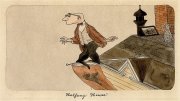Hiram S. Hunn ’21 came to Cambridge in 1931 to celebrate his tenth reunion. In Harvard Yard he discovered workmen razing Appleton Chapel to make way for Memorial Church. On the ground lay this stained glass window. What’s to become of that? he asked the foreman. Would you like it? was the reply. Of course, said Hunn, whereupon workers crated the glass, about three feet in diameter, and shipped it to Hunn’s law office in Des Moines, says Dwight Miller, senior admissions officer, who had the story from Hunn himself.

Appleton Chapel, of light sandstone, took shape starting in 1856 in what architectural historian Bainbridge Bunting has described an “an ungainly mixture of Classical and Romanesque.” The Harvard Book noted in 1875 that “The early history of the Chapel is one of prolonged disaster….” The organ was unsatisfactory, the acoustics deplorable, and the roof came apart. Improvements in 1873 added refinements. “New windows, of richly stained glass, bearing the motto ‘Christo et Ecclesiæ’ below, and ‘Veritas’ above, were substituted for the former plain ones, and added much to the elegance of the place.”
Hunn indefatigably interviewed prospective students for Harvard for more than 55 years in Iowa and Vermont. Today, the Office of Admissions and Financial Aid honors him with awards in his name to alumni recruiters. Each fall Hunn closed his law office for a week, picked a quadrant of the state of Iowa he had not visited recently, and drove to rural schools, beating the bushes. Candidates who visited his Des Moines office for an interview could admire the backlighted Veritas window. When Hunn died in 1984, his widow gave the relic to Humphrey Doermann ’52, former director of admissions. He has now passed it to the admissions office, and it hangs in Byerly Hall, “a tangible symbol,” its new owners state, “of the power of Harvard’s loyal graduates—working together—to strengthen the College through diversity.”
A grant from the McLaughlin Foundation, of which James E. McGrath ’77 is president, permitted the cleaning and mounting of the window, which admission officials believe to be “the oldest original piece of stained glass at Harvard.” A consulting expert in stained glass explains that the crimson shield displays “flashed” glass, a thin layer of glass fused to a white underlayer. The letters are painted in vitreous enamel and fired in a kiln to fuse them to the glass. The panel represents a venerable European tradition of leaded colored and painted windows, different in style from the later American Opalescent windows of Harvard’s Memorial Hall. Good for savior Hunn.





